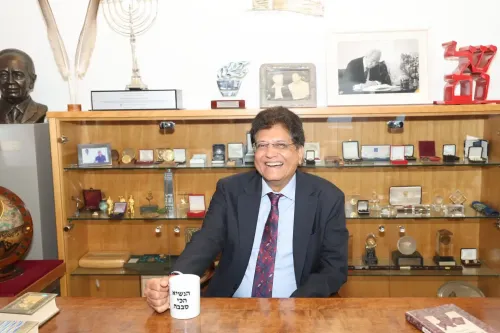Innovative Technique by Indian Scientists to Boost Next-Gen Lighting

Synopsis
Key Takeaways
- Innovative method to reduce anion migration in perovskite nanocrystals.
- Minimizes heat and moisture sensitivity, enhancing stability.
- Central to developing efficient optoelectronic devices.
- Pioneering research published in Nanoscale.
- Potential applications in next-generation lighting solutions.
New Delhi, Feb 21 (NationPress) Researchers at the Centre for Nano and Soft Matter Sciences (CeNS) in Bengaluru, an autonomous institute under the Department of Science and Technology (DST), have pioneered a groundbreaking approach to reduce anion migration in CsPbX₃ perovskite nanocrystals.
Reducing anion migration in these perovskite nanocrystals is crucial as it can help minimize sensitivity to heat and moisture, along with color instability, thereby facilitating the creation of efficient, long-lasting optoelectronic devices, according to the researchers in a study published in the journal Nanoscale.
Lighting accounts for approximately 20 percent of global electricity usage, and innovations in lighting technology have significantly enhanced energy efficiency. The journey from traditional incandescent and fluorescent bulbs to the advent of LEDs in the 1960s has been remarkable.
A watershed moment came in 1993 when the development of high-brightness blue LEDs by Shuji Nakamura and his team enabled the creation of energy-efficient white LEDs (WLEDs), a milestone that earned them the 2014 Nobel Prize in Physics.
Currently, LEDs dominate the market in terms of efficiency and lifespan, with OLEDs providing vibrant colors and QLEDs (Quantum Dot LEDs) offering precise color control and durability. Additionally, micro/mini-LEDs are emerging as key players in the future of lighting.
Despite the advantages, thin and flexible OLEDs are expensive and have shorter lifespans, while QLEDs pose toxicity issues and face challenges regarding resource scarcity. Furthermore, Micro/Mini-LEDs are restricted in application due to high manufacturing costs.
“Perovskite LEDs (PeLEDs), which belong to a class of compounds having the same crystal structure as CaTiO3 – Calcium Titanate, merge the benefits of OLEDs and QLEDs, making them an excellent candidate for next-gen lighting,” stated the team led by Dr. Pralay K. Santra from CeNS.
“However, their widespread adoption is hindered by issues such as sensitivity to heat and moisture, coupled with color instability resulting from anion migration (the movement of halide ions—chloride, bromide, or iodide—between quantum dots in mixed layers),” they elaborated.
To address this challenge, Santra synthesized green light-emitting cesium lead bromide (CsPbBr₃) perovskite nanocrystals using a hot injection method, employing oleylamine as a passivating ligand.
To boost stability, they utilized argon-oxygen (Ar-O₂) plasma treatment, which immobilizes surface ligands by forming a cross-linked, hydrophobic layer.
This technique effectively stabilizes the ligands and slows down anion exchange, significantly enhancing color stability. The research provides crucial insights into stabilizing perovskite nanocrystals, paving the way for efficient and durable optoelectronic devices.









